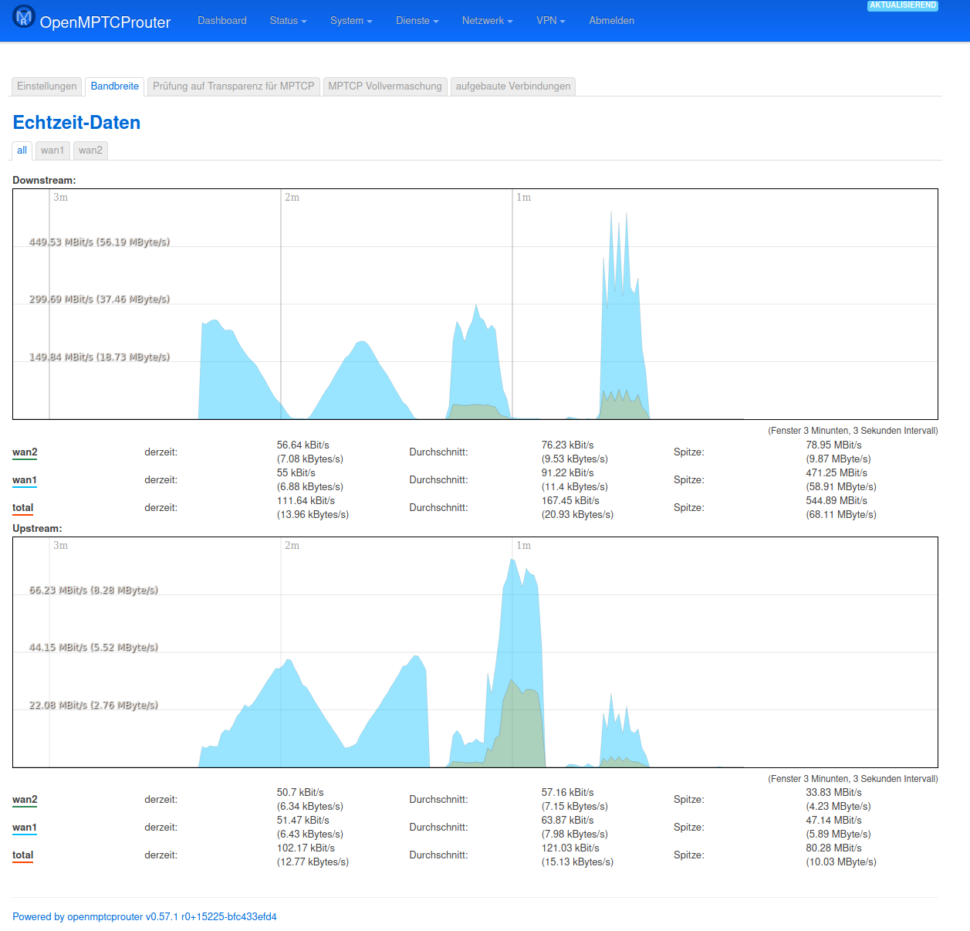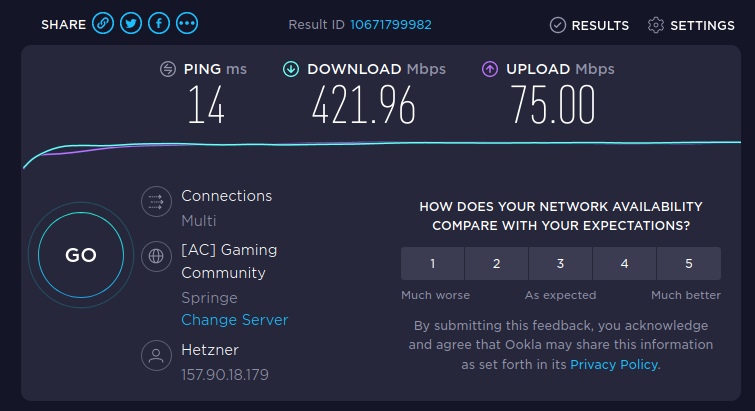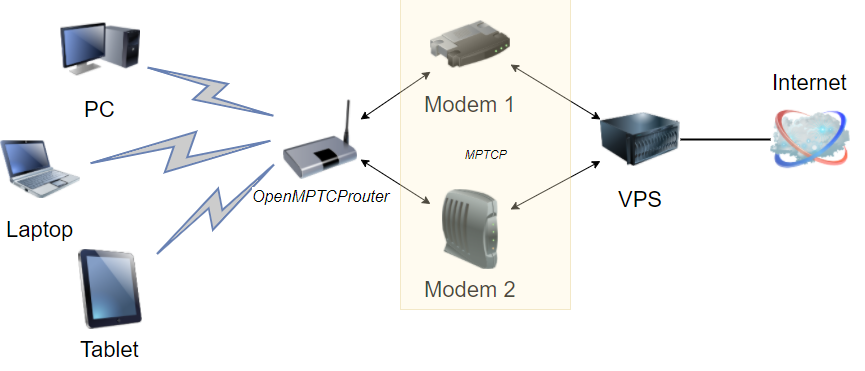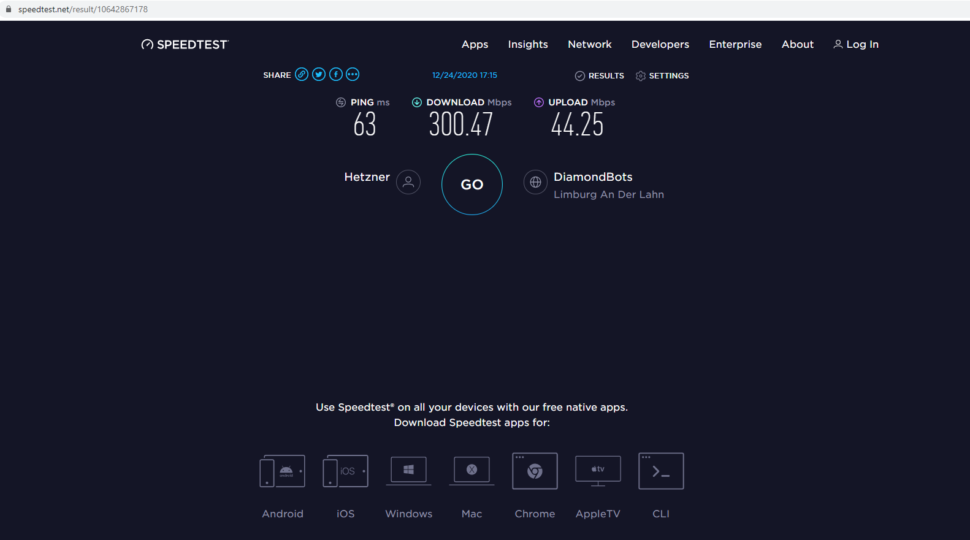With Hybrid LTE, Telekom offers a tariff that combines a DSL connection with data transmission via LTE. I wondered whether it would be possible to implement something like this myself and came across the project openmptcprouter ...in the past. The idea here is to bundle several Internet connections and thus increase the bandwidth.
In my setup, one of the modems is tethering my iPhones to a Odroid C2 realized: thanks to the MagentaEINS Plus contract I have another connection with 250 Mbit/s available. Ideally, the bandwidth should be doubled, unlike with pure failover, the second line is not only used when the first fails, but used all the time.
In the diagram above, the server called "VPS" may stand out: this is a "Virtual Private Server" (alternatively, a complete root server would also work), which reunites the data packets and directs them to the Internet under a common IP address - if this point is not fast enough, the bandwidth limits here. I decided to use a VServer from Hetzner, but other providers are also possible. On the project website there are scripts that make all the necessary settings - last but not least, the kernel must be exchanged for a variant with MPTCP support (multi-path TCP), which is why I took the recommended Debian 10.
If you have set up everything so far, the status in the OpenMPTCProuter should look like this:
To say it in advance: so far I didn't reach the double bandwidth, the maximum was just over 300 Mbit/s (with unfortunately quite bad ping):
There can be several reasons for this, my setup for testing had several points where speed can be lost:
- Tethering connection between smartphone (iPhone 12 Pro) and Odroid-C2 (which replaces the "LTE-Router" in my setup)
- Connection speed of the mobile phone (especially the upload via 5G remains in most cases at 10 Mbit/s instead of the 40 Mbit/s possible in the tariff)
- WLAN connection between LTE router and router with OpenMPTCProuter installation
- LAN connection between OpenMPTCP router and Fritz!Box (the 2nd Internet connection in the setup)
- Speed of the VPS from Hetzner (assembling the packages needs some computing power, at my end I solved the problem with a Pentium G4650 and 8 GB RAM)
- The fact that I started the speed tests from a virtual machine and ran two networks in parallel
In a "clean" setup you would avoid the overlap in the network, and use less wifi connections. With an LTE router and a 2nd SIM card it would be easier to realize, maybe I'll do the effort for it again if this post gets enough interest.
The idea behind this setup would be, for cases where you need more bandwidth (Steam updates, other larger downloads) to use the otherwise idle bandwidth of the home WLAN of the mobile phone - which actually works to some extent, but still far from the desired result. Basically, however, it is an exciting approach that I will continue to pursue. If someone who is reading along here could already gather experience with such a setup I would be happy about a comment!

Update: better performance with TP-Link MR600 LTE router
After I already had the assumption that an LTE connection via tethering is not the optimum, I ordered a data SIM and a TP-Link MR600 LTE router without further ado. The latter supports LTE connections with a maximum of 300 Mbit/s downstream and 50 Mbit/s upstream and can thus fully utilize the 250/40 Mbit/s available. Reconnected as a WAN, I have at least in speed tests significantly better values:

In order to achieve this bandwidth, however, considerable effort was required:
- Data SIM with 250 Mbit/s for EUR 10 per month as part of the MagentaEINS Plus contract
- TP-Link MR600 to take full advantage of the LTE bandwidth ([amazon fields="B07RS7HM59″ value="price"])
- Fritz!Box 7590 (or another Super-Vectoring capable modem)
- PC with Pentium G4560, 8 GB RAM, with Gigabit LAN
- Gigabit LAN switch to connect the whole thing together
In addition, there is the effort to integrate the additional devices in the network in such a way that in the end three DHCP servers do not compete for the clients - it would probably be easier if the control of the network were run completely via the OpenMPTCPRouter. What I'm actually missing now is the appropriate application purpose for this bandwidth.
An alternative to this complete do-it-yourself solution is the tool "Speedify", which allows easy configuration for a small fee (at least currently) and achieves similar connection speeds.



Hey I have something planned with a Rutx12 does that make any sense for me? I thought it so set it up so that in the LTE router (RUTX12) can use mobile.
so on the road but there I can not achieve a faster connection or?